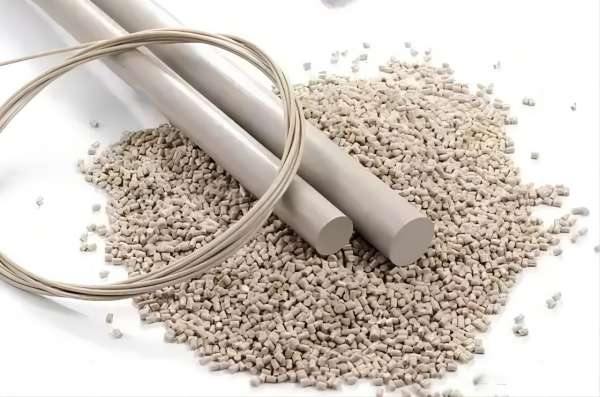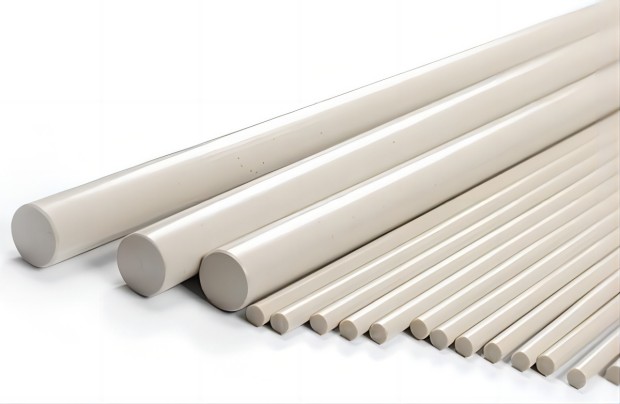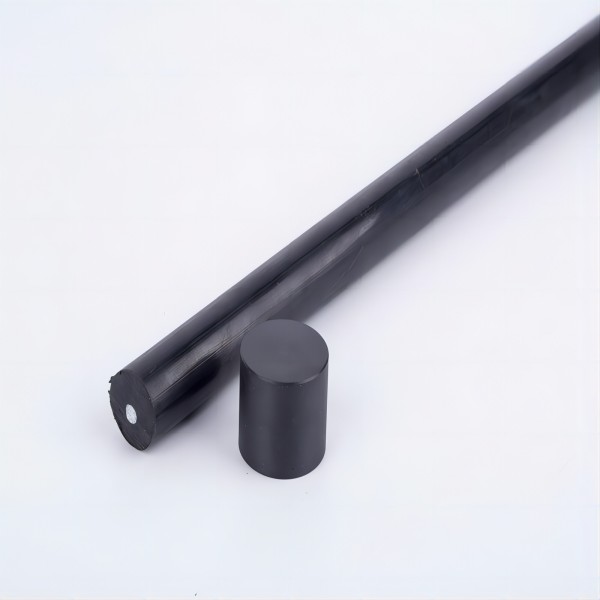
Privacy statement: Your privacy is very important to Us. Our company promises not to disclose your personal information to any external company with out your explicit permission.
PEEK rods on the market diameter model range is generally between 3-260mm, normal 1m/3m long, PEEK rods are made of PEEK raw material particles extruded through the extrusion equipment extrusion molding semi-finished profiles, PEEK rods are widely used in small batches of large sizes or injection molding and other processes can not meet the requirements of the product machining.
PEEK rods are mainly available in five grades and models: pure PEEK rods, PEEK carbon fiber reinforced (+30% CF) rods, PEEK glass fiber reinforced (+30% GF) rods, PEEK bearing grade (+10% PTFE +10% graphite +10%) rods, PEEK anti-static rods.
PEEK is a high-temperature-resistant thermoplastic with high glass transition temperature (143°C) and melting point (334°C), and loaded thermal deformation temperature up to 316°C (30% glass fiber or carbon fiber reinforced grades).
In different application scenarios, materials can be selected or special customized as required. Pure PEEK rods have more complete market specifications due to the range of applications, cheaper prices and larger market capacity, while other grades of PEEK rods need to look at each company's own specifications, with fewer options.
PEEK-1000 (Brownish Gray): PEEK-1000 is manufactured from pure polyether ether ketone resin and has the best toughness and impact resistance of any PEEK grade. PEEK-1000 can be sterilized using the most convenient sterilization methods (steam, dry heat, ethanol, and Y-rays), and the raw material composition used to manufacture PEEK-1000 meets European Union and U.S. FDA regulations for food safety, making it suitable for very common applications in the medical, pharmaceutical, and food processing industries.
PEEK-HPV (black): The addition of PTFE, graphite and carbon fiber makes PEEK-HPV a bearing grade plastic. Its superior frictional properties (low coefficient of friction, wear resistance, high peak pressure limit) make this grade ideal for friction applications.
PEEK-GF30 (brownish gray): A reinforced grade filled with 30% glass fibers, this material has better stiffness and creep resistance than PEEK-1000, as well as better dimensional stability, making it ideal for structural parts. It is ideal for structural parts. It can withstand fixed loads at high temperatures for extended periods of time. If PEEK-GF30 is used as a sliding part, its suitability should be carefully tested because glass fibers scratch the mating surface.
PEEK-CA30 (black): Reinforced with 30% carbon fiber filler, this material has better mechanical properties (higher modulus of elasticity, mechanical strength, and creep) and is more wear-resistant than PEEK-GF30, and the carbon-fiber-reinforced plastic is 3.5 times more thermally conductive than unreinforced PEEK - dissipating heat from the bearing surfaces more quickly.

PEEK polyether ether ketone material selection criteria
PEEK can also be called polyether ether ketone, as a high-performance semi-crystalline plastics, such plastics have excellent chemical resistance, mechanical strength, dimensional stability and a series of good performance, according to the performance is divided into a variety of series of materials, the most common classification of PEEK materials are PEEK pure material, glass fiber or carbon fiber modification.
#peek material #PEEK pure material is PEEK is the most widely used PEEK plastic, in addition to the excellent properties mentioned earlier, PEEK pure material also shows particularly high toughness in the PEEK series. We can see that the elongation at break is 15%, and although PEEK Pure is tough, the material has a modulus of elasticity of only 4,200mpa, the lowest in the family of plastics. This relatively low modulus means that PEEK pure is 'softer' and less abrasion resistant than other PEEK modifiers. Therefore, if you are using PEEK pure in frictional working conditions, be aware of material loss due to wear of the material.
01 Chemical resistance
PEEK pure material in chemical resistance, PEEK pure material is the best chemical resistance in the PEEK family, it can be said that only 98% of concentrated sulfuric acid can dissolve PEEK pure material, general chemicals, simply can not play any role in it, the resistance of different chemicals is also different, but also showed resistance to steam hydrolysis, is the production of high temperature disinfection of instruments need to be made of the ideal material.
02 Lightweight and strong
The light weight of PEEK pure material is also worth mentioning, the density of the material is only 1.31g/cm3. In the aerospace industry, the plastic has been used for structural components due to its light weight and good mechanical strength.
03 Good insulation, excellent electronic properties
Another excellent property of PEEK pure material is insulation, which is the core key to oil logging technology. For some industries where the working conditions are both high temperature and high pressure, such as the oil and gas industry, it is able to maintain insulation and high mechanical strength in extreme environments.
In addition, PEEK plastic also shows excellent electronic properties, it has a very stable dielectric constant and low dissipation factor, which makes the material can be used in telecommunications technology.

PEEK 30% Glass Fiber Filled
PEEK GF30 is a glass fiber filled PEEK pure plastic. Due to the glass fibers, the biggest difference between PEEK GF30 and PEEK pure is the modulus. PEEK GF30 has a modulus value of 6,300 mpa, the highest in the PEEK family, and the high modulus value means that PEEK GF30 has higher stiffness and wear resistance compared to PEEK pure. Correspondingly higher stiffness makes the plastic more brittle.
01 Excellent Wear Resistance PEEK GF30 material has an elongation at break of 5%, a particularly smooth surface and a low surface coefficient, making the material suitable for applications requiring rigid friction rather than impact.
02 Low deformation temperature More importantly, PEEK GF30 due to the addition of glass fibers, in the same, high temperature and high pressure deformation is lower than the PEEK pure material, when the temperature exceeds the glass transition temperature of the PEEK more than 150 ℃, the material will be glassy, in this case, recrystallization occurs, it will be correspondingly, reduce the mechanical strength of the PEEK material, but for PEEK GF30 due to the presence of glass fibers, the recrystallization rate will be reduced, so that if the PEEK pure material and PEEK GF30 in the same high temperature and high pressure working conditions, the deformation temperature of PEEK GF30 will be lower.

PEEK 30% carbon fiber filled
PEEK CA30 is a 30% carbon fiber filled plastic based on PEEK pure material, compared to PEEK pure material, the carbon fiber increases the modulus while maintaining maximum toughness of the material.The modulus of elasticity of PEEK CA30 is 6000mpa and the elongation at break is 10%. So PEEK CA30 is a material that maintains very high stiffness and relatively high toughness.
In addition, carbon fiber modified PEEK exhibits excellent wear resistance and very good friction properties : PEEK CA30 has better wear resistance compared to PEEK GF30. In addition, carbon fibers conduct heat more efficiently. PEEK CA30 is therefore suitable for sliding applications.
November 17, 2024
November 16, 2024
August 27, 2021
August 26, 2021
PEEK ball is a special type of ball made of polyether ether ketone (PEEK), which has excellent chemical stability, abrasion resistance, and high temperature resistance.PEEK ball is widely used in...
PVDF Application Areas Different models of PVDF products are suitable for different application scenarios. According to application fields, PVDF can be divided into conventional grade products and...
Application Performance Advantages of MC nylon MC nylon is a new type of engineering plastics, due to its outstanding comprehensive performance, so that its status in engineering plastics is rapidly...
Types of nylon: 1. Nylon - 6 (PA6) Nylon -6, also known as polyamide -6, that is, polycaprolactam. Translucent or opaque opalescent resin. 2. Nylon - 66 (PA66) Nylon-66, also known as polyamide-66,...
Email to this supplier
November 17, 2024
November 16, 2024
August 27, 2021
August 26, 2021

Privacy statement: Your privacy is very important to Us. Our company promises not to disclose your personal information to any external company with out your explicit permission.

Fill in more information so that we can get in touch with you faster
Privacy statement: Your privacy is very important to Us. Our company promises not to disclose your personal information to any external company with out your explicit permission.